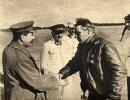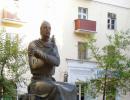Location of the bridge on the inner surface of the skull. The pons of the brain - structure and functions. Signal conduction and integrative functions of the bridge
Varoliev Bridge - an element of the central nervous system, located between the midbrain and medulla oblongata.
In the body, it plays two roles: conducting (ensures the transmission of nerve impulses from the spinal cord to parts of the brain) and connecting (ensures the coordinated functioning of individual structures). It received its name in honor of the famous anatomist - Constanzo Varolius.
The pons consists of a tegmentum (upper part), which contains the nuclei of the 5th to 8th pairs of cranial nerves, they are represented by gray matter, and a base (lower part), which contains pathways.
The anatomy of the bridge also includes the following structures:
- reticular formation - a large neural network and a cluster of nuclei that control the activity of the nervous system;
- pathways in the form of thickened nerve cords connecting to the cerebellum.
In appearance, it resembles a thickening attached to the brain stem, and posteriorly bordering the cerebellum. Below it passes into the sections of the medulla oblongata, and above it borders on the middle brain.
The pons originates during embryonic development from the rhomboid vesicle. During the process of differentiation, it is divided into the hindbrain and medulla oblongata.
The cerebellum subsequently forms from the hindbrain. The nuclei of the cranial nerves are initially located in the medulla oblongata, and with the development of the fetus, after birth, they change their location, moving to the pons.
In a newly born child, this structure is located above the sella turcica. By the age of 8, all nerve fibers are covered with a sheath of myelin.
What functions does it perform?
Tasks for which the pons is responsible:
- controls the execution of targeted movements;
- regulates the spatial orientation of the body;
- provides sensitivity to facial skin, mucous membranes, responsible for facial expressions and sense of smell;
- provides the function of chewing, swallowing, salivation;
- takes part in the formation unconditioned reflexes, for example, in inhalation and exhalation (breathing regulation function);
- takes part in sleep mechanisms. It is known that the reticular formation is involved in the phases of wakefulness and sleep. There is a connection between it and the limbic-hypothalamic structures. When the latter is excited, the structures of the reticular formation are inhibited, and when awake, on the contrary, they are activated.
- participates in the regulation of vestibular function, analyzes vestibular stimuli;
- it contains the centers of the nerves responsible for eye movement in different directions, tension of the muscle fibers of the soft palate, the functions of the eardrum, etc.
Possible pathologies and their diagnosis
The significance of the bridge can be assessed based on the influence of pathologies (syndromes) that damage individual functions of the body.
Common causes that lead to disruption of its functioning include: mechanical brain injuries, multiple sclerosis, stroke, cyst, tumor. In diagnosing pathologies, specialists primarily rely on the manifestation of symptoms, from which syndromes are formed.
The most common of them include:
- Bonnier syndrome is accompanied by damage to the nuclei of the auditory and vestibular nerves. In this case, the patient becomes dizzy, hearing loss occurs, and trigeminal neuralgia may occur. Common symptoms include weakness, depression, and sleep disturbances.
- Locked-in syndrome (ventral pontine syndrome) is a condition in which consciousness and full sensitivity are retained, but the ability to speak is completely lost. The function of the extraocular muscles is preserved. Communication with others is possible using non-verbal gestures. The condition is preceded by signs confirming insufficiency of the blood supply artery: double vision, dizziness, unsteadiness of gait.
- Raymond-Sestan syndrome (another name is oral tegmentum syndrome) is a combination of paralysis of the muscles responsible for the movement of the eyeball on the side opposite to the lesion. Etiological factors: atherosclerotic changes in cerebral vessels, tumors, ischemic strokes.
- Millard-Hübler syndrome is manifested by paralysis of the facial muscles on the affected side, along with which there is partial paralysis on the opposite side. This disease manifests itself in pathologies at the base of the bridge. Constriction of blood vessels or micro-stroke predisposes to pathology, for example, if there is a cavernous angioma in a given structure with subsequent damage to the structures of the vascular system. Less commonly, the cause may be neurosyphilis or diffuse glioma.
- Foville syndrome is a combined lesion of individual elements of the facial and abducens nerves. The pathology is expressed in complete paralysis of the facial muscles in combination with strabismus. Often the cause of its development is ischemic stroke, less often tumor-like formations, inflammation.
- Gasperini syndrome is caused by the occurrence of pathology in the area of the bridge tire. It affects the nuclei of several nerves at once (facial, trigeminal, vestibulocochlear abducens). From the location of the pathological focus on the opposite side, a person feels a sensitivity disorder. The clinical picture includes strabismus, dizziness, and ataxia. This condition occurs due to ischemia, tumors, and inflammation.
- Grenet's syndrome is a sensory disorder with simultaneous damage to the muscles responsible for chewing on the affected side. On the opposite side, hemihypesthesia is noted. Often, pathology can occur due to ischemic changes in the branches of the posterior cerebral artery.
- Brissot-Sicart syndrome is a set of signs of damage to the nucleus of the facial nerve with partial paralysis of the limbs. Clinically manifested by a spasm of the facial muscles, which is accompanied by peripheral paralysis of the facial nerve and hemiparesis. Its occurrence is associated with ischemia and previous infectious diseases.
Help to clarify the location, duration of the lesion, volume and other parameters of the pathological process modern methods magnetic resonance imaging.
BRAIN BRIDGE [pons(PNA, JNA), pons Varolii(BNA); syn. pons] - part of the brain stem that is part of the hindbrain (metencephalon).
Anatomy
The bridge is located between the medulla oblongata and the cerebral peduncles, and on the sides it passes into the middle cerebellar peduncles (Fig. 1). From the base of the brain, the bridge is a dense white shaft measuring 30 X 36 X 25 mm. The anterior surface of the bridge is convex, facing forward and downward and is adjacent to the clivus at the base of the skull. The basilar groove (sulcus basilaris) runs in the middle of the anterior surface, in which lies the basilar artery (a. basilaris), which is the main source of blood supply to the MG.
Behind the pons of the brain, from the groove between the medulla oblongata, on the one hand, the pons and the middle cerebellar peduncle, on the other, the roots of the abducens, facial, intermediate and vestibulocochlear nerves emerge sequentially.
The posterior surface of the bridge faces upward and backward, into the cavity of the fourth ventricle, and is not visible from the outside, because it is covered by the cerebellum. It forms the upper half of the bottom of the diamond-shaped fossa.

On transverse (frontal) sections of the M. g.m. (Fig. 2), a more massive anterior (ventral) part (pars ant. pontis), or base (basis pontis, BNA), and a small posterior (dorsal) part (pars post, pontis), or tire (tegmentum, BNA). The boundary between them is the trapezoidal body (corpus trapezoideum), formed mainly by processes of cells of the anterior cochlear nucleus (nucleus cochlearis ant.). Clusters of nerve cells form the anterior and posterior nuclei of the trapezoid body (Gudden's nuclei). The front part of the bridge contains ch. arr. nerve fibers, between which numerous small accumulations of gray matter are scattered - the nuclei of the bridge (nuclei pontis). In the nuclei of the bridge, the fibers of the cortical-pontine tract (tractus corticopontini) and collaterals from the passing pyramidal tracts end. The processes of the cells of the pons nuclei form the cerebellopontine tract, the fibers of which pass predominantly to the opposite side and are the transverse fibers of the bridge (fibrae pontis transversae). The latter form the middle cerebellar peduncles (pedunculi cerebellares medii).
The rear part of the axle (tire) is much thinner. It contains the reticular formation (formatio reticularis) and the nuclei of the V, VI, VII, VIII pairs of cranial nerves. At the level of the middle of the bridge there is the motor nucleus of the trigeminal nerve (nucleus motorius n. trigemini), and somewhat laterally there is the superior sensory nucleus (nucleus sensorius sup.). The latter is approached by fibers from the sensory cells of the trigeminal ganglion, which, as part of the sensory root, enter the substance of the bridge at its border with the middle cerebellar peduncle. Adjacent to the sensory root is the motor root, which is the processes of the cells of the motor nucleus of the trigeminal nerve.
At the level of the facial tubercle is the nucleus of the abducens nerve; nearby, in the reticular formation, is the motor nucleus of the facial nerve, the processes of the cells forming a knee that goes around the nucleus of the abducens nerve. Behind the motor nucleus of the facial nerve is the superior salivary nucleus (nucleus salivatorius sup.) and outside the latter is the nucleus of the solitary tract (nucleus tractus solitarii). In the inferolateral part of the tegmentum of the bridge are located the nuclei of the vestibular-cochlear nerve (n. vestibulocochlearis). On the sides of the trapezoid body are the superior olives. The processes of the cells of the superior olive (oliva sup.) make up the lateral loop (lemniscus lat.), between the fibers of the latter is the nucleus of the lateral loop. (nucleus lemnisci lat.). The lateral lemniscus also includes processes of cells of the posterior nucleus of the cochlear nerve (nuci, cochlearis post.), the nuclei of the trapezoid body and the nucleus of the lateral lemniscus.
Inward from the superior olive above the trapezoid body there is a medial loop (lemniscus med.), which is a bundle of fibers of proprioceptive sensitivity, and a spinal loop (lemniscus spinalis) - a bundle of fibers along the path of pain and temperature sensitivity.
Functions
The important function and significance of the M. g. m. is due, on the one hand, to the location in it of the nuclei of the cranial nerves (V, VI, VII, VIII pairs), reticular formation, and pons nuclei; on the other hand, the passage through the M. of efferent pathways (corticospinal and cortico-nuclear, tegmental-spinal cord, red nucleus-spinal cord, reticular-spinal cord, etc.) and afferent pathways (spinothalamic, conduction pathways of proprioceptive - deep - sensitivity, etc.), which are of vital importance for the body and carry out two-way communication between the head brain (see) and spinal cord (see).
Pathology
Depending on the localization of the lesion in the pathology of M. g. m., various wedges and syndromes develop. Loeb and Meyer (C. Loeb. J. S. Meyer, 1968) distinguish ventral, tegmental and lateral pontine syndromes, as well as various combinations thereof (eg, bilateral ventral syndrome, ventral and lateral syndromes, ventral and tegmental syndromes, bilateral tegmental syndrome).

Ventral pontine syndrome, which develops with unilateral damage to the middle and upper (rostral) part of the base of the bridge (Fig. 3, b-IV, c-VII), is characterized by contralateral hemiparesis or hemiplegia, with bilateral damage - quadriparesis or quadriplegia, and occasionally lower paraparesis; quite often pseudobulbar syndrome develops (see Pseudobulbar palsy); in some cases, a disorder of pelvic functions is observed. Damage to the caudal part of the base of the bridge (Fig. 3, a-II) is characterized by Millard-Hübler syndrome (see Alternating syndromes). Tegmental pontine syndrome occurs when the posterior part (tire) of the bridge is affected. A lesion in the caudal third of the tegmentum (Fig. 3, a-I) is accompanied by the development of lower Foville syndrome (Fauville-Millard-Gübler syndrome), with homolateral damage to the VI and VII cranial nerves and paralysis of gaze towards the lesion. When the caudal part of the tegmentum is affected, Gasperini syndrome is also described, which is characterized by homolateral damage to the V, VI and VII cranial nerves and contralateral hemianesthesia. Lesions in the middle third of the tegmentum (Fig. 3, b-III) are characterized by Grene's syndrome (crossed sensory syndrome): homolateral disturbance of sensitivity on the face, sometimes paralysis of the masticatory muscles, contralaterally - hemihypesthesia; sometimes ataxia and intention tremor are observed in the homolateral limbs due to damage to the superior cerebellar peduncle. A lesion in the rostral third of the tegmentum (Fig. 3, c-VI) often causes Raymond-Sestan syndrome (see Alternating syndromes), also called upper Foville syndrome. Damage to the tegmentum in this third of the bridge, in particular damage to the superior cerebellar peduncle (Fig. 3, c-v), can also lead to the development of myoclonus of the soft palate (“nystagmus” of the soft palate), and sometimes the muscles of the pharynx and larynx. With acute damage to the bridge tire, severe impairment of consciousness may also occur. Lateral pontine syndrome (Marie-Foy syndrome), associated with damage to the middle cerebellar peduncles (Fig. 3, c - VIII), is characterized by the presence of homolateral cerebellar symptoms; sometimes, with more extensive damage, cross hemihypesthesia and hemiparesis are observed.
With total damage to the bridge, there is a combination of signs of bilateral ventral and tegmental syndromes, sometimes accompanied by the so-called. locked-in syndrome, when the patient cannot move his limbs or speak, but he retains consciousness and eye movements. This syndrome is a consequence of true paralysis of the limbs and anarthria as a result of bilateral damage to the motor and corticonuclear pathways. The syndrome externally resembles akinetic mutism (see Movements, pathology), which is caused by a violation of the impulse to action in the absence of paralysis in the patient.
From patol, processes most often in the region of M. g. m. there are heart attacks as a result of occlusive, usually atherosclerotic, damage to the vessels of the vertebrobasilar system; less frequent are hemorrhages that develop as a result of arterial hypertension. The syndromes observed in these cases are characterized by great polymorphism, but the presence of classical alternating syndromes is not very common. The clinical picture of infarction varies depending on the level of vascular damage to the vertebrobasilar system and the possibilities of collateral circulation. Wedge, the manifestations of hemorrhages in the bridge depend on the topic of the lesion, the rate of their development and the presence or absence of blood breakthrough into the fourth ventricle. Rarely occurring arteriovenous malformations (aneurysms) in the area of the bridge are characterized by a progressive increase in neurol, symptoms associated with damage to the bridge, trigeminal neuralgia; their sudden rupture with subarachnoid and parenchymal hemorrhage is possible. Saccular aneurysms can also cause hemorrhages.
In the area of the bridge there are tumors (gliomas) and tuberculomas (see Brain). The early stages of gliomas, when the lesion is unilateral, as well as tuberculomas, usually localized in the tegmentum, are characterized by the presence of alternating pontine syndromes; later, as the patol process spreads, damage to a number of cranial nerve nuclei, as well as pyramidal and cerebellar tracts is observed (due to effective anti-tuberculosis therapy, tuberculomas have become rare). Wedge, signs of involvement of the M. g. m. may appear as the tumor of the cerebellopontine angle grows.
The defeat of M. g.m. is often observed in acute poliomyelitis, which is usually clinically manifested by “nuclear” paralysis of the facial muscles.
The most common type of traumatic injury to the pons is hemorrhage into its parenchyma, which develops along with hemorrhages in other parts of the brain.
Wedge, a picture of central pontine myelinolysis, which is based on acute death of the myelin sheaths in the central part of the myelin sheath, is characterized by rapidly progressing pyramidal disorders up to quadriplegia, pseudobulbar palsy, tremor, rigidity, mental and intellectual impairment, and death over several weeks or months. The etiology of the disease is unclear, but there is a connection with hron, alcoholism and eating disorders.
Treatment of M.'s lesions is carried out taking into account the nature of the patol. process and its stages.
Bibliography: Antonov I. P. and Gitkina L. S. Vertebro-basilar strokes, Minsk, 1977, bibliogr.; Bekov D. B. and M and x i l about in S. S. Atlas of arteries and veins of the human brain, M., 1979; B l u m e n a u L. V. The human brain, p. 129, L.-M., 1925; Bogolepov N.K. et al. Nervous diseases, p. 44, M., 1956; Differential diagnosis of cerebral hemorrhages and cerebral infarctions in the acute period, ed. G. 3. Levina pi G. A. Maksitsova, p. 77, L., 1971; Zh at the island and G. P. Neural structure and interneuron connections of the brain stem and spinal cord, M., 1977; K r about l M. B. and F e d o-r about in and E. A. Basic neuropathological syndromes, M., 1966; Vascular diseases of the nervous system, ed. E. V. Schmidt, p. 308, M., 1975; T r and m-f about in A. V. Topical diagnosis of diseases of the nervous system, L., 1974; Adams R. D., Victor M. a. Manca 1 1 E. L. Central pontine myelinolysis, Arch. Neurol. Psychiat. (Chic.), v. 81, p. 154, 1959; B a i 1 e at O. T., B r u n o M. S. a. O b e r W. B. Central pontine myelinolysis, Amer. J. Med., v. 29, p. 902, 1960; Gottschick J. Die Leistungen des Nervensystems, Jena, 1955; Handbook of clinical neurology, ed. by P. J. Vinken a. G. W. Bruyn, v. 2, p. 238, Amsterdam - N.Y., 1975; KemperT.L.a. Romanul F. C. State resembling akinetic mutism in basilar artery occlusion, Neurology (Minne-ap.), v. 17, p. 74, 1967; O 1 s z e w s k i J. a. Baxter D. Cytoarchitecture of the human brain stem, Basel - N. Y., 1954; Plum F. a. P o s n e r J. Diagnosis of stupor and coma, Philadelphia, 1966.
D. K. Lunev; V.V. Turygin (an.).
The human brain occupies a key position in regulating all systems of the human body. With the help of this organ, a connection is made between the activities of organs and all systems. Without brain coordination, a person cannot exist.
Thanks to the initially configured work of the central nervous system, we can move, speak and perform many other functions.
The human brain has the most complex structure, and each of its sections is responsible for its own functions. Thus, all brain structures support the functioning of the body as a whole.
The main parts of the brain include the pons. It contains such centers necessary for human life as:
- Vascular
- Respiratory
It is also what initially forms the majority of cranial nerves.
The key component of the main functioning organ is the neuron. She is responsible for receiving, processing and storing data. The entire human brain is literally filled with these cells and their processes, which ensure the transmission of signals to organs. The brain also includes gray and white matter.
The key structural parts of the brain are:
- Right and left hemispheres (Responsible for our memory, thought processes, imagination)
- Cerebellum (coordinates and shapes our motor system). It is thanks to the cerebellum that we can move, feel balance, body position
- Pons

Structure of the pons
The structure of the bridge from the outside appears in the form of a cushion, which includes cranial nerves, arteries, reticular formation and descending tracts. From the inside it appears as half of a diamond-shaped fossa.
The basilar groove runs along the median path, flanked by pyramidal elevations. If you make a cross section, then cellular level white matter can be seen.
In the lateral section the nuclei of the superior olive are located, namely in the area of the anterior base and posterior tire. Between these parts there is a line that appears to be numerous fibers. Experts identify this multiple accumulation of fibers as the trapezoidal body, which is responsible for the formation of the auditory pathway.
The border that separates the pons and the middle cerebellar peduncle is called the region where the trigeminal nerve branches.

Functions
The pons provides a number of important functions for the human body, namely:
- Provides targeted control over body movements
- Allows you to perceive the body in space
- Controls the sensitivity of the tongue, facial skin, nasal mucosa and eye membranes
- Responsible for facial expressions and hearing
- Coordinates the entire act of food consumption (swallowing, salivation, chewing)
The reflex function performed by the bridge allows the human central nervous system to respond to various external stimuli (reflex). Reflexes are divided into 2 types:
- Conditional, which are acquired in the process of life with the possibility of adjustment
- Unconditioned, which are not amenable to consciousness and are laid down at the moment of birth (chewing, swallowing and other reflexes)
The bridge also performs the function of ensuring the relationship between the cerebral cortex and the underlying formations. The fibers themselves are directed directly to the cerebellum, spinal cord and medulla oblongata. This transition is possible due to the passage of descending and ascending paths through the bridge.
All important functions of the pons are achieved through the cranial nerves.
For example, the 5th pair of cranial nerves is responsible for the perception of pain and tactile sensations, and also ensures the act of chewing. The abducens nerves contain motor fibers, which provide the ability to turn the eyes. The work of the respiratory center of the medulla oblongata also depends on the bridge.

Pathological conditions
It is worth highlighting that one of the key parts of the brain, the pons, as well as the cerebral peduncles are affected much more often than the same medulla oblongata. They are often in a pathological condition due to embolism, arthritis or thrombosis. In these places, hemorrhages, tumor formations, and infections, such as tubercles, most often occur.
The presence of such pathologies is quite difficult to diagnose; often, specialists establish an accurate diagnosis using differentiated diagnostics from case to case. However, today there are main syndromes that are distinguished by a certain clinical picture.
The brain and pons are distinguished by the following types of syndromes:
- Inferior pontine syndrome
It is the earliest established pathology. It is located on the entire ventral part of the transection of the Varoliev bridge in its lower sections. IN in this case The following clinical picture is observed:
- Hemiplegia of the central type
- Peripheral paralysis of the facial and abducens nerves, also most often damage to paired nerves located on the opposite side, that is, on the side of the lesion
- Hemianesthesia, when the facial nerves are affected on the affected side, and the body and limbs are on the opposite
- In rare cases, hemichorea and hemiataxia
- Upper pontine syndrome or Raymond-Sestan syndrome
The pathology is localized in the posterolateral part of the bridge, and the pathological manifestations are as follows:
- Minor hemiparesis without obvious variability of tendon and skin reflexes
- Hyperkinesis - athetosis, tremor
- Dysarthria
- Vertical nystagmus
- Frequent dizziness
The spinal cord and brain are independent structures, but in order for them to interact together, one formation is required - the pons. This element of the central nervous system acts as a collector, a connecting structure that links the brain and spinal cord together. That's why education is called that - bridge, from what connects two key organs of the central and peripheral nervous system. The pons is part of the structure of the hindbrain, to which the cerebellum is also attached.
Structure
Varolievye formation is located on the basal surface of the brain. This is the location of the bridge in the brain.
Talking about internal structure– the bridge consists of clusters where their own nuclei (clusters) are located. On the posterior part of the bridge lie the nuclei of the 5th, 6th, 7th and 8th pairs of cranial nerves. An important structure lying on the territory of the bridge is the reticular formation. This complex is responsible for the energetic activation of higher-lying elements of the brain. The retinal formation is also responsible for activating the wakeful state.
Externally, the bridge resembles a cushion and is part of the brain stem. The cerebellum is adjacent to it posteriorly. Below the bridge passes into, and from above into the middle one. The structural features of the cerebral bridge are the presence of cranial nerves and many pathways in it.
On the back surface of this structure is located rhomboid fossa- This is a small depression. The upper part of the bridge is limited by the medullary stripes, on which the facial hillocks lie, and even higher by the medial eminence. A little to the side of it there is a blue spot. This colored formation is involved in many emotional processes: anxiety, fear and rage.
Functions
Having studied the location and structure of the bridge, Costanzo Varolii wondered what function the bridge performs in the brain. In the 16th century, during his life, the equipment of individual European laboratories did not allow answering the question. However, modern research has shown that the Varoliev Bridge is responsible for the implementation of many tasks. Namely: sensory, conductive, reflex and motor functions.
Located in it VIII pair cranial nerves performs the primary analysis of sounds coming from outside. This nerve also processes vestibular information, that is, it controls the location of the body in space (8).
Task facial nerve– innervation of facial muscles of the human face. In addition, the axons of the VII nerve branch and innervate the salivary glands located under the jaw. Axons also extend from the tongue (7).
V nerve– trigeminal. Its tasks include the innervation of the masticatory muscles and the muscles of the palate. Sensory branches of this nerve transmit information from receptors in the skin, nasal mucosa, surrounding skin of the apple and teeth (5).
In the Varoliev bridge there is a center that activates exhalation center, which is located in the adjacent structure below - the medulla oblongata (10).
Symptoms of the lesion
Disturbances in the activity of the Varoilic pons are determined by its structure and functions:
- Dizziness. It can be systemic – a subjective sensation of surrounding objects moving in any direction, and non-systemic – a feeling of loss of control over one’s body.
- Nystagmus– forward movements of the eyeballs in a certain direction. This pathology may be accompanied by dizziness and nausea.
- In the case where areas of the nuclei are affected, the clinical picture corresponds to damage to these nuclei. For example, with a disorder of the facial nerve, the patient will exhibit amimia(full or flaccid) – lack of muscle strength in the facial muscles. People with such a lesion have a “stony face.”






